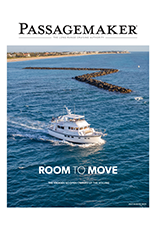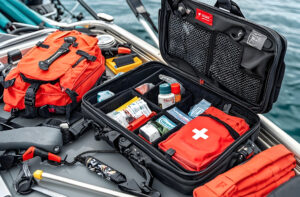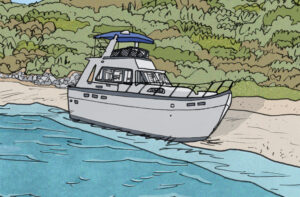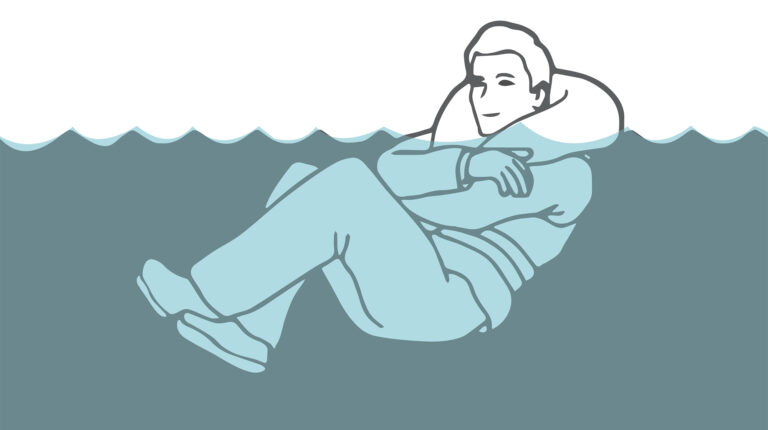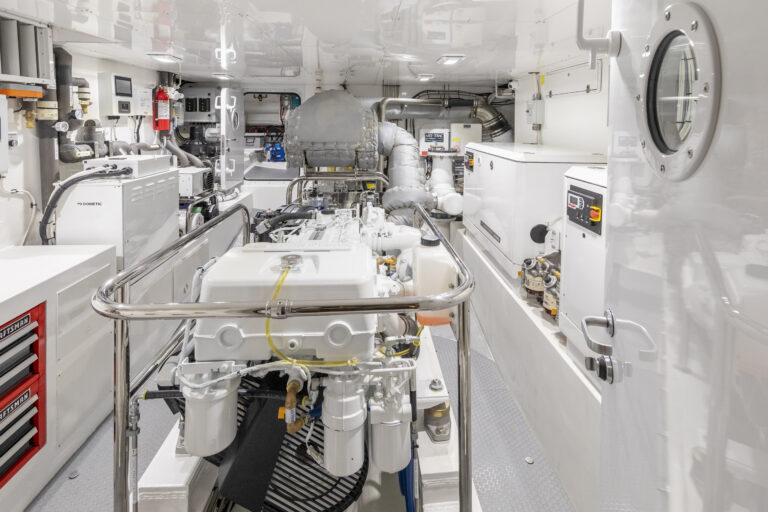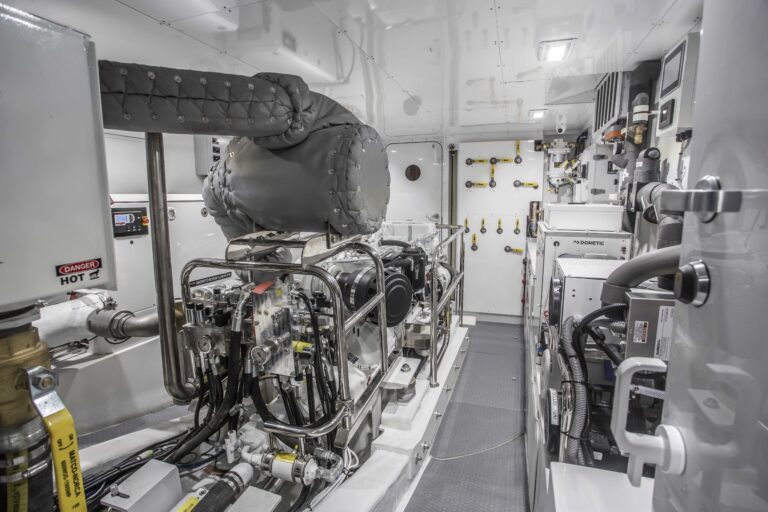For us, the dream of cruising centers on freedom, adventure, discovery, challenge, camaraderie, and plain old fun! Yet the reality can be dramatically different when preparation fails to meet opportunity. My wife JoAnne and I have arrived at four guidelines to safer, more enjoyable passages that have served us well. While each taken alone at face value may seem like obvious common sense, taken together and given some color they move the odds strongly in favor of less risk and more fun.
These easy-to-remember guidelines may help you think through the underlying details associated with your own boat, crew, and cruising plans, resulting in safer, more enjoyable passages. As to why these might be worthy of your consideration, here’s a brief summary of my nautical background: I have 50 years of boating and cruising experience, sailing part time inland and then offshore. Fifteen years ago, my wife and I transitioned to trawlers, and in 2005, we built a Nordhavn for full-time ocean cruising. Lastly, I hold an active USCG 100-ton master’s license for power and sail on both offshore and inland waters.
Guideline 1: Weather Is King
On any pleasant, light-wind day when we’re near the coast and the seas are flat, we see a remarkable number of small boats either fishing or cruising around within a few miles of shore. Occasionally, we see small boats even farther out. Our observation is that when conditions are right, practically anything that floats can be operated near-coastal by just about anyone. Unfortunately, such benign conditions can change quickly, whether due to a developing onshore wind against an inlet’s outgoing tide or a pop-up thunderstorm or an extensive squall line.
Weather information is available from a range of technologies and sources to provide reasonably accurate forecasts. However, we have found that we should be prepared for sea conditions that may be twice as unfavorable as forecasted, even on short, overnight coastal hops. When in port and local forecasts are unfavorable, we either wait it out or make an informed judgment about a worst-case scenario relative to the capabilities and limitations of the vessel and its crew.
While cruising, we monitor weather conditions, maps, and/or forecasts via weather fax, VHF radio, SSB radio, and/or satellite, depending on which sources are available with the best information. The reality of forecasts and maps are that, for the most part, they are synoptic, covering a large area; whereas the weather we might actually experience on a passage could be different due to very localized conditions.
In summary, we’ve found that by picking good weather windows, we’ve generally avoided unpleasant or dangerous conditions and enhanced our cruising pleasure. While this must seem ridiculously obvious, it takes on deeper meaning when placed in context with the following three guidelines.
Guideline 2: Know The Capabilities And Limitations Of Your Vessel
I have found that one way to know many of the capabilities and limitations of a vessel is to do as much maintenance as possible myself. This enables me to learn about the boat and its systems, and reduce “surprise” limitations by performing timely and correct maintenance. When something fails or is showing initial signs of failure, I am grateful that I can usually detect and diagnose the problem quickly. It helps also that I carry an inventory of spares and tools for making either proper or temporary repairs for most problems.
When we were deciding to either buy or build our last trawler, it was tempting to focus on the capabilities that confer “bragging rights,” rather than what they either can do or should not do in various scenarios. For example, when you tell someone you have a boat, isn’t it true that generally the first question they ask is, “How big is it?” We resisted the temptation to impress others and focused instead on as many scenarios we might encounter and thought through, for example, how we wanted the boat to perform, our safety and comfort, serviceability, back-up capabilities, and maintenance.
“Scenario planning” helps me to think through what it will be like and what we would do when encountering various situations. It has served well even when considering such mundane scenarios as docking under a variety of conditions or embarking and disembarking at the different types of docks we encounter. But it is especially valuable in the scenarios where the vessel and crew may be at serious risk. These include for us rough weather, fire, grounding, medical problems, and collision.
To illustrate the technique with a simple example, when we built our last trawler I wanted to be able to easily perform a Mediterranean moor, where the boat is tied to a dock stern-to. The criteria I selected for the scenario was doing it in close quarters with a 15-knot cross wind. My thinking was that if we can do that, we can dock under any reasonable set of conditions pretty much anywhere. As a result of working through what we’d need on the boat to do this, we decided to incorporate both bow and stern thrusters of a sufficient size.
After the boat was built with these features, within a week I was convinced they’d paid for themselves already. While this capability was somewhat expensive, it did make it so much easier to dock and maneuver in close quarters pretty much anywhere and under most conditions. Since I don’t feel a need to prove that I can dock the boat without them, and I believe that I can still do it, this easy way out paid off.
Guideline 3: Know The Capabilities And Limitations Of The Crew
It is very easy to be a good captain and have a competent crew when on the water in ideal conditions. The challenge comes to me when unexpected things happen or circumstances change. Crew fatigue occurs fairly rapidly when either the passage is short-handed or the weather deteriorates. On a recent passage to Bermuda from Ft. Lauderdale, we encountered unexpectedly strong winds and large head seas for six out of seven days. I was assisting the couple that owned the boat, and we all became seasick. Still, with three on board and a little sickness management, fulfilling duties and schedules worked out fine aboard a vessel that was capable of taking far more than its crew.
Another scenario we consider is that if something happens to me as the captain, I need to know that one of the crew will be able to safely bring the vessel into port. Similarly, it’s my responsibility to ensure that one of the crew can call for help on either the VHF radio or the satellite phone, for example, in the case of a life-threatening emergency.
I train crew on the operation of the vessel, its communications equipment, and watch-standing procedures. In addition, I cover safety, fire fighting, and abandon-ship procedures. However, an area where I need to do more is in training crew to maneuver the vessel in close quarters and practicing with both me and them conducting rescue operations. I find this hard to do as often as it should be done, because it requires sacrificing both time in port and at sea. I suspect this last point might resonate with a number of readers.
As captain, it is my responsibility to ensure that the crew and I are up to whatever we may reasonably encounter. Thinking through various scenarios can be a valuable tool for visualizing needs and taking appropriate preparatory steps.
Guideline 4: Never Say, “We’ve Got To Be There!”
As a hobby, I try to understand the causes of catastrophic accidents on recreational vessels and small planes. One observation is that there are usually multiple contributing elements to such catastrophic events. Surprisingly, a common factor in nearly every case was the decision that “they had to be there.” To me, this is the most common and serious issue that a captain and crew must consider.
On a trip last year from Acapulco, Mexico, to Barillas, El Salvador, I struggled with this issue. I responded to a request for crew on a couple’s vessel who were new to cruising. The owners were concerned about the conditions offshore in general and the infamous Tehuantepec winds in particular. We had emailed each other about my participation and the float plan.
I had understood it to be a two-week time frame, but once on board learned that it was more likely a three-week schedule. Based on my initial understanding, my version of the schedule “wisely” provided for extra time to ensure that we made the passage in favorable weather conditions. Due to commitments I had made, I was now under pressure and struggling with reconciling how much to influence the owners over trip planning, based on what I felt would be safe and reasonable conditions for the passages. We made it safely and in generally comfortable conditions, by my standardsperhaps not theirs.
I re-learned three things from this part of that experience. First, there are always situations where pressure to “be there” will feed my emotional drive and tempt rationalization of the facts. Second, in the future I’ll ensure clear communication by all parties concerned with any planned voyage. Third, I won’t make commitments anywhere for a couple of weeks following my expected arrival at the destination. These three re-learned lessons should enable avoiding as much as possible being in a position where I start to compromise my own Guideline 4.
Turning the above situation around, when we’ve had guests on board, I’ve always told them up front that we may not arrive in port on time to meet them, and we may not get to the next port in time for them to make their travel arrangements. Consequently, they must be flexible on both ends, which has worked well.
Summary
No matter how one looks at boating, whether as a sport or an avocation or adventure or relaxation or anything else, it should be and can be all that we want in terms of safety and comfortthat is, the dream realized as the “real deal.” We have found that a useful way to help reasonably meet these expectations is by using the framework offered with these four guidelines. We especially like that they are so simple that they can be easily remembered and then recalled to stimulate thought and discussion about specific actions related to the vessel, crew, and planned cruise. They have paid us pleasant and rewarding returns in the form of greater enjoyment and peace of mind. If you like them, I hope that they serve you as well as they have served us.
